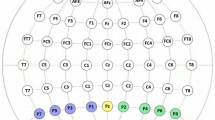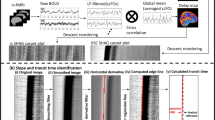Abstract
Many event-related functional magnetic resonance imaging paradigms performed so far have been designed to study a limited part of the brain with high temporal resolution. However, event-related paradigms can be exploratory, therefore requiring whole brain scans and so repetition times (TR) of several seconds. For these large TR values, the slice acquisition order may have an important effect on the detection of event-related activation. Indeed, when the scanning is interleaved, the temporal delay between the acquisition of two contiguous slices can reach a few seconds. During this time, the subject is likely to move, and the haemodynamic response will vary significantly. In this case, the interpolation applied between contiguous slices for motion correction induces a temporal smoothing between voxels that are spatially close but temporally sampled a few seconds apart. This should modify the frequency structure of the response and may impair the detection of short events. We, therefore tested the effect of three acquisition schemes (sequential, sequential with gap and interleaved. INT) at two repetition times (TR = 3 and 6 s on six and seven subjects, respectively) on activation detection and frequency content in a visual motion event-related paradigm. Unexpectedly, tor large TR (6 s), results were found in favour of the INT acquisition scheme(P <0.05). For smaller TR. no strong bias could be found. Generally, intra-subject variability (across acquisition schemes) is found to be much smaller than inter-subject variability, confirming the importance of multi-subjects analyses. Our study also shows that important physiological information is carried by high frequency components that should not be filtered out.
Similar content being viewed by others
References
Grabowski TJ, Damasio AR. Improving functional imaging techniques: the dream of a single image for a single mental event. In: Proceedings of the National Academy of Science USA, vol. 93(25), 1996, p. 14302–303 (commentary).
Buckner RL, Bandettini PA, O’Craven KM, Savoy RL, et al. Detection of cortical activation during averaged single trials of a cognitive task using functional magnetic resonance imaging. In: Proceedings of the National Academy of Science USA, vol. 93, 1996, p. 14878–883.
Schad L, Wiener E, Baudendistel K, Müller E, et al. Event-related functional MR imaging of visual cortex stimulation at high temporal resolution using a standard 1.5 T imager. Magnetic Resonance Imaging 1995; 13(6):899–901.
Wiener E, Schad L, Baudendistel K, Essig M, et al. Functional MR imaging of visual and motor cortex stimulation at high temporal resolution using a FLASH technique on a standard 1.5 Tesla scanner. Magnetic Resonance Imaging 1996; 14(5):477–83.
Josephs O, Rees G, Turner R, Friston K. Event-related fMRI. In: Third International Conference on Functional Map** of the Human Brain, Copenhagen, Denmark. Neuroimage 1997;5:S483.
Schluter N, Josephs O, Toni I, Friston K, et al. Testing the association of haemodynamic responses with different tasks events using fMRI. In: Third International Conference on Functional Map** of the Human Brain, Copenhagen, Denmark. Neuroimage 1997;5:S359.
Song AW, Jezzard P, Lalonde FM. The effect of slice-selection profile on fMRI contrast. In: Fifth ISMRM meeting. Vancouver, Canada, 1997, p. 1627.
Howseman AM, Grootoonk S, Porter D, Ramdeen J, et al. The effect of slice order and thickness on fMRI activation data using multislice echo-planar imaging. Neuroimage 1999;9:363–76.
Josephs O, Henson RN. Event-related functional magnetic resonance imaging: modelling, inference and optimization, Philos Trans R Soc Land B Biol Sci 1999;354:1215–28.
Howseman AM, Porter D, Josephs O, Turner R. The effect of slice order and orientation on fMRI activation using whole brain multislice EPI. In: ISMRM. 1997, p. 1626.
Friston KJ. Characterizing modulatory interactions between VI and V2 in human cortex with fMRI. Hum Brain Map** 1995;2:189–210.
Worsley KJ, Friston KJ. Analysis of fMRI time-series revisited-again. Neurolmage 1995;2:173–81.
Bullmore E, Brammer M, Williams S. Statistical methods of estimation and inference for functional MR image analysis. Mag Resonance Med 1996;35:261–77.
Zarahn E, Aguirre GK, D’Esposito M. Empirical analysis of BOLD fMRI statistics. I. Spatially unsmoothed data collected under null-hypothesis conditions. Neuroimage 1997;5:179–97.
Holmes A, Josephs O, Buchel C, Friston KJ. Statistical modelling of low frequency confounds in fMRI. In: Third International Conference on Functional Map** of the Human Brain. Copenhagen, Denmark. Neuroimage 1997;5:S480.
Author information
Authors and Affiliations
Corresponding author
Rights and permissions
About this article
Cite this article
Paradis, A.L., Van de Moortele, P.F., Le Bihan, D. et al. Slice acquisition order and blood oxygenation level dependent frequency content: an event-related functional magnetic resonance imaging study. MAGMA 13, 91–100 (2001). https://doi.org/10.1007/BF02668157
Received:
Revised:
Accepted:
Issue Date:
DOI: https://doi.org/10.1007/BF02668157




